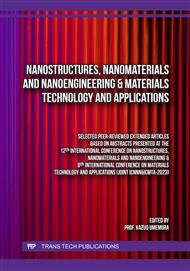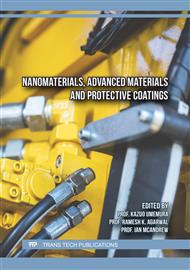[1]
A. Nishimura, Y. Izumi, S. Nishijima, T. Hemmi, and T. Shikama, "FISSION NEUTRON IRRADIATION EFFECT ON INTERLAMINAR SHEAR STRENGTH OF CYANATE ESTER RESIN GFRP AT RT AND 77 K," American Institute of Physics, 2010.
DOI: 10.1063/1.3402293
Google Scholar
[2]
K.Bittner-Rohrhofer, K.Humer, and H.W. Weber, "Low-temperature tensile strength of the ITER-TF model coil insulation system after reactor irradiation," Cryogenics, 2002.
DOI: 10.1016/s0011-2275(02)00039-5
Google Scholar
[3]
K. Humer, K. Bittner-Rohrhofer, H. Fillunger, R. K. Maix, R. Prokopec, and H. W. Weber, "Radiation effects on the mechanical properties of insulators for fusion magnets," Fusion Engineering and Design, vol. 81, no. 20-22, pp.2433-2441, 2006.
DOI: 10.1016/j.fusengdes.2006.07.065
Google Scholar
[4]
K. Bittner-Rohrhofer, "Characterization of reactor irradiated organic and inorganic hybrid insulation systems for fusion magnets," presented at the AIP Conference Proceedings, 2002.
DOI: 10.1063/1.1472551
Google Scholar
[5]
T. Hemmi et al., "Development of insulation technology with Cyanate Ester resins for ITER TF coils," Fusion Engineering and Design, vol. 84, no. 2-6, pp.923-927, 2009.
DOI: 10.1016/j.fusengdes.2009.01.083
Google Scholar
[6]
J. W. Li, Z. X. Wu, C. J. Huang, and L. F. Li, "Gamma irradiation effects on cyanate ester/epoxy insulation materials for superconducting magnets," (in English), Fusion Engineering and Design, Article; Proceedings Paper vol. 89, no. 12, pp.3112-3116, Dec 2014.
DOI: 10.1016/j.fusengdes.2014.09.012
Google Scholar
[7]
Z. X. Wu, R. J. Huang, C. J. Huang, and L. F. Li, "Properties of radiation stable insulation composites for fusion magnet," in Joint Meeting of the 1st Asian International Cryogenic Materials Conference (ICMC) / 50th Anniversary Conference of the Cryogenics-and-Superconductivity-Society-of-Japan (CSSJ), Kanazawa, JAPAN, 2016, vol. 897, BRISTOL: Iop Publishing Ltd, 2017.
DOI: 10.2221/jcsj.51.145
Google Scholar
[8]
P. E. Fabian, "Highly radiation-resistant vacuum impregnation resin systems for fusion magnet insulation," presented at the AIP Conference Proceedings, 2002.
DOI: 10.1063/1.1472555
Google Scholar
[9]
P. E. Fabian, N. A. Munshi, S. W. Feucht, K. Bittner-Rohrhofer, and H. W. Weber, "Low Temperature Mechanical Properties of Cyanate Ester Insulation Systems After Irradiation," American Institute of PhysicsAIP, 2004.
DOI: 10.1063/1.1774581
Google Scholar
[10]
N. A. Munshi et al., "Radiation Resistant Electrical Insulation Qualified for ITER TF Coils," IEEE Transactions on Applied Superconductivity, vol. 23, no. 3, pp.7700104-7700104, 2013.
DOI: 10.1109/tasc.2012.2231723
Google Scholar
[11]
S. J. Canfer et al., "Development of a filled resin system for the TF coils of ITER," Fusion Engineering and Design, vol. 86, no. 9-11, pp.2504-2507, 2011.
DOI: 10.1016/j.fusengdes.2011.04.040
Google Scholar
[12]
M. W. Hooker et al., "Industrialization of Radiation-Resistant Cyanate Ester Magnet Insulation," IEEE Transactions on Applied Superconductivity, vol. 19, no. 3, pp.2367-2370, 2009.
DOI: 10.1109/tasc.2009.2018749
Google Scholar
[13]
R. Prokopec et al., "Qualification of a cyanate ester epoxy blend supplied by Japanese industry for the ITER TF coil insulation," 2012.
DOI: 10.1063/1.4712086
Google Scholar
[14]
J. Hill et al., "Risk Mitigation for Cyanate Ester Insulation of Large Magnets Through Cure Optimization," IEEE Transactions on Applied Superconductivity, vol. 25, no. 3, pp.1-5, 2015.
DOI: 10.1109/tasc.2014.2376172
Google Scholar



